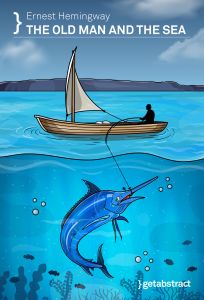
The Old Man and the Sea
- Novella
- Modernism
What It’s About
The Struggle for Existence
The old man, his boat, the admiring boy, the sea, a few clouds, two or three fish, a few birds, the great marlin and finally the sharks – those are the ingredients of this famous novella. Stripping out the complications of modern life, Hemingway presents a story of one man’s timeless struggle both with and against the elements. Survival isn’t simply a Darwinian struggle to determine the fittest, but a need to persevere despite challenges and setbacks: to rise to the occasion but also accept that events can turn a success into a failure. It’s the need to go to sleep at the end of a harrowing ordeal with the simple idea that tomorrow you’ll get up and try again. The work of an aging author, The Old Man and the Sea focuses on the realities of growing old and the desire to remain vital and relevant. Much like the old man in the book, Hemingway found himself looking back on his early successes while finding it ever harder to repeat them. As such, his last completed work of fiction was a triumph over his critics, who had basically declared him finished as a novelist. In the middle of a confusing 20th century and with his characteristically economical style, Hemingway makes the battle of this lone fisherman off the coast of Cuba into a poignant story of humanity’s struggle to find meaning.
Summary
About the Author
Ernest Hemingway was born on July 21, 1899, in Oak Park, Illinois. The son of a country doctor and an opera singer, he learned hunting and fishing from his nature-loving father, laying the groundwork for Hemingway’s fascination with nature and the image of a bluff outdoorsman that he would later cultivate. He started his career as a local reporter in Kansas City. His beginnings as a journalist shaped his minimalistic style as a novelist later in life. During World War I, he volunteered as a paramedic, joining a group of writers and artists around Gertrude Stein in Paris after the war. He spent the winters of 1925 and 1926 in the Austrian Montafontal, where he wrote the novel The Sun Also Rises. Published in 1926, it was his literary breakthrough. Hemingway continued to work as a reporter and war journalist, covering the Greco-Turkish war in 1922, the Spanish Civil War from 1936–1939 and World War II in the ’40s. In 1940, For Whom the Bell Tolls was published. In 1954, he was awarded the Nobel Prize in Literature after the publication of The Old Man and the Sea. Hemingway often deliberately sought out dangerous, adventurous and risky situations. He loved big-game hunting in Africa and bullfighting and survived two plane crashes, often writing his novels under intense psychological pressure. Like many writers of his day, he was an alcoholic, trying to live life to the fullest but also suffering from depression. Hemingway married four times and had three sons. After a long illness, he committed suicide on July 2, 1961, in his home in Idaho – as had his father before him and his granddaughter Margaux after him.








Comment on this summary